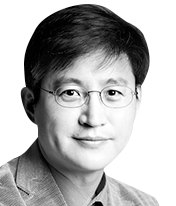Minimum wage battle between two underdogs

Lee Sang-ryeol
The author is an editorial writer of the JoongAng Ilbo.
Minimum wage has been a cruel test on the Korean economy. As soon as a liberal government was launched under President Moon Jae-in, the minimum wage for the following year of 2018 was hiked by a whopping 16.4 percent. In 2019, it was bumped up by 10.9 percent. The minimum wage per hour that was at 6,470 won ($4.9) in 2017 jumped to 7,530 won and 8,350 won in the following years to meet President Moon’s campaign promise to achieve a minimum wage of 10,000 won within his five-year term.
To the chagrin of the government, the job market was shattered. The monthly payroll additions of 200,000 to 400,000 in 2017 shriveled in the following year. By July 2018, the job increase against a year-ago period stopped at 5,000. In August, the number was smaller at 3,000 — the worst job data since the contraction of 10,000 in January 2010 from the global financial crisis. Since the economy was otherwise doing well, the cause behind the job catastrophe pointed to the sudden jump in the minimum wage ardently pushed under the so-called income-led growth policy of the Moon administration.
The bottom-up concept was that if income increases, consumption will grow to stimulate the economy. But the question is how to raise income. The income-led growth policy found the answer in higher minimum wage. The theory would work when the employers can afford the rise. Large companies could afford the increase in the minimum wage. But most of the self-employed and smaller companies could not. In order not to break the law, they had to choose one of the two — either closing their business or cutting their employees.
The disruption hit mostly the vulnerable class. Many lost jobs from small companies, restaurants, convenient stores and singing rooms run by the self-employed. Part-time jobs became rare. The catastrophic results stemmed from the naïve belief that an increase in the statutory minimum wage can better the income and lives of the working class. The concept neglected the simple truth that wages can increase when employers can afford to.
The Moon administration slowed the pace of the increase amid the disastrous impact on the job market. In 2020, it escalated the minimum wage by only 2.9 percent. President Moon apologized for failing to meet his promise to deliver the minimum wage of 10,000 won within three years in office.
His policy chief Kim Sang-jo — a former liberal professor of economics — said, ”Someone’s income is a cost for another. When the income and cost is balanced, the economy can move in a benign cycle.” But the realization came too late as the job market had already been ruined.
The minimum wage experiment left lasting scars on the economy at a crossroads. The surge of temps working fewer than 15 hours a week is one. They do not get any legal protection or benefits such as holiday pay, severance pay or annual holidays. Owners of mom-and-pop stores sought several hourly hires for one position. Job openings were common for 14.5 hours a week. Those employed on such poor terms without proper income and job security totaled 1.55 million in May, adding by 620,000 from 930,000 in May 2017, shortly before Moon’s administration was launched. In workplaces employing fewer than five, 30 percent do not get minimum wage.
The Minimum Wage Commission enters negotiations to set next year’s rate. The labor community demands a hike of 26.9 percent to 12,210 won per hour, while the employers’ side argues for a freeze at 9,620 won. Although inflation rate has come down from 5 to 6 percent level to 3.3 percent in May, it still hovers far above the target rate of 2.0 percent. If the minimum wage stays unchanged, it could mean a wage cut when accounting for the inflation rate. Still, there are too many merchants who cannot afford a further hike in the minimum wages. The minimum wage system aims to protect the low income workers. But the wage system remains unchanged regardless of the disaster. The labor market is structured to hurt the weaker parties if the minimum wage goes up too high. Merchants have been calling for a differentiated rate system by industry. But the proposal continues to be ignored. If the minimum wage rises again next year, the weaker parties will have to struggle again.










with the Korea JoongAng Daily
To write comments, please log in to one of the accounts.
Standards Board Policy (0/250자)